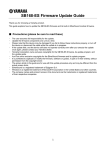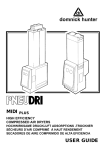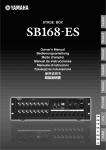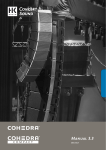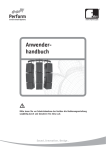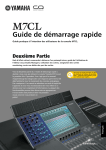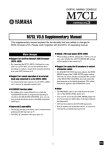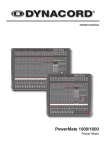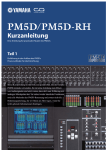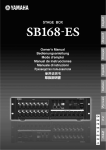Download Yamaha DME8o-ES Specifications
Transcript
YAMAHA System Solutions white paper Networked audio system design with ES100™ This white paper’s subject is Networked audio system design with ES100™. The design concepts in this paper support systems varying from small touring event setups to medium scale integrated live installations. That does not mean that these design concepts are the best solution to all system specifications, other network topologies and audio protocols should always be considered in the initial phase of the design project. The advantage of these Yamaha System Solutions design concepts is that they are based on Ethernet / ES100™, both open protocols that use computer networking components widely available on the market. Other compatible brands of both network and audio equipment can be included in the design concepts, assuring maximum flexibility and project efficiency for system integrators. It is also good to know that the design concepts are not just a theoretical exercise; we have built, tested and installed many systems based on these design concepts so you can be confident that they will work in real life. We assume the reader is a system integrator with detailed knowledge of analogue and digital audio, and basic knowledge of networking technologies as covered in the ‘Yamaha System Solutions - an introduction to networked audio’ white paper. The Yamaha Commercial Audio team. ES100™ networked audio systems 1. System design 2. EtherSound 3. ES100 4. ES100 audio routing 5. Redundancy issues 6. Connectivity issues 7. ES100 audio only redundant ring design 8. ES100 integrated redundant ring design 9. Yamaha ES100 devices 10. Programming ES100 devices 11. Documentation 12. Troubleshooting 13. Example 1: 48ch FOH - MON - stagerack 14. Example 2: 32ch FOH - MON - dual stagerack - amprack The complete package 1. System design Customer’s requirements Design options Design tools The first step in any design is to chart the customer’s requirements. Sometimes the requirements can be found in a formal tender if a consultant has already been involved in the customer’s system specification process. In many cases the consultant or system integrator has to discuss the customer’s requirements in depth to find the most appropriate system specifications, and perhaps suggest additional system possibilities made possible by new technologies on the market. Based on the system specifications document basic design options can be conceived. The main decision to make is the selection of the technology to be used: analogue or digital, point to point or networked, closed (proprietary) or open (manufacturer-independent) platforms etc. These decisions are fundamental as they determine the degree of freedom allowed in further design stages. The more complex a system the more important design tools become. A small system can be described in words or an excel sheet, but larger or more complex systems have to be described in drawings to be able to communicate them to all stakeholders in a project. In modern times software programs are used to construct system designs such as AutoCAD in the contracting business, StarDraw in the audio markets. Selection of network and audio devices System test After the technology platforms have been selected the system’s actual network and audio devices must be selected. Input parameters for selection include feature The second step is to draw up a system specification based on the customer’s requirements. A system specifi- set, audio quality, technical reliability, supplier reliability and of course cost level. There are few products with an cation document contains the requirements for a system to fullfill as operational parameters. The system specifica- ‘A-score’ on all of these parameters; quality comes with tions should not include any direction to actual solutions higher costs, reliability as well. The designer must study each system component’s feature set in depth to assess as that would narrow the scope of possibilities in the if it meets the system specifications or not, and conceive design stage. Only by keeping the system specifications creative solutions in case no matching products are availand the design solution options strictly separated can able. the broad scope of choices be truly considered by the designer, allowing for maximum flexibility, quality and creativity in the design stage. System specifications A very important part of the network design process is to conduct (sub) system tests. Especially network systems using managed switches offer an extremely high functionality level that require system tests to verify that all parameters have been programmed correctly. Training & after sales A networked audio system offers different functionality compared to analogue systems. Therefore the design of appropriate after sales and training activities for future users of the system is an important part of the design stage. 2. EtherSound The beginning At the turn of the century, three R&D engineers at Digigram studied Ethernet compliant audio distrbiution methods, with CobraNet as the world standard at that time. CobraNet has been developed to function in large scale, complex applications - but the three engineers didn’t have such a broad application scope in mind - they narrowed it down to the live sound reinforcement market, requiring much simpler topologies and protocols. They ended up with EtherSound version 1.0 - developed to serve one-way connections from a mixing console to a speaker controller / amplifier setup using only an inexpensive CAT5 cable. Their new technology was applied in a large scale live application for the first time in September 2003 by the sound reinforcement department of Radio France during a performance of the opera Carmen - driving 16 loudspeaker stacks located throughout the 80.000 seat arena ‘Stade de France’ in Paris. Everybody involved was taken by surprise - Digigram provided a full working system, doing exactly what was needed for this job - but in a much simpler way. The protocol Remember how the engineers from Peak Audio solved the timing and sync problem - caused by Ethernet latency - in the Cobranet protocol ? One CobraNet device sends out a beat packet on a moment the network is quiet - so it can travel to all other devices with extremely low delay. Carmen at the Stade de France, Paris Then - after receiving the beat packet at virtually the same time - all audio devices send their audio - with every device waiting for a fixed amount of time before the received audio is output. This method provides the time buffer required to cope with store/forward and queue delays in the network. That’s CobraNet in a nutshell. The inventors at Digigram made one genius simplification - stating simply that the network must be a daisy chain. In a daisy chain every device has only one source device to receive data from, and one destination device to send data to - so the device doesn’t have to study the MAC address in the Ethernet packet to decide where the packet must go. This also means that store/forward and queue delays never ever occur in an EtherSound system. The EtherSound chips from Digigram are capable of forwarding an Ethernet packet in just 1,4 microseconds. In the audio world we start to worry only if a delay grows above 11 microseconds ( which is half a sample at 48kHz ), so a daisy chain with up to 7 devices is no problem at all. And as the delay can be calculated exactly - knowing the 1,4 microsecond delay of an EtherSound device - systems with more than 7 devices can be tuned to be in sync with short digital delays of a few samples. EtherSound Version 1 EtherSound version 1 packs the 24-bit samples of 64 audio channels in one packet and sends it down the daisychain with a pace of 48.000 packets per second. EtherSound 1.0: downstream daisy chain. The number of packets is equal to the sampling rate of 48kHz, so the receiving device can use the packet stream as a source to get a stable wordclock. All devices in the daisy chain receive packet after packet, quickly replacing and/or inserting individual samples in the packets before sending the packet further on its way - all in 1,4 microseconds. A device that inserts audio into the packet stream is called a ‘master’ device, a device extracting channels from the packet stream is called a ‘slave’ device. At the end of the daisy chain, the last device, the audio packets are sent to the last connector with nothing connected to it - these packets end up in silicon heaven (don’t feel sorry for them - it’s like being stuck in an elevator with Brigitte Nielsen). Inside the packets also some control data is transmitted by the first device in the network to control settings of all other devices. This first device is always a ‘Master’ device - the first device to input audio channels in the packet stream. So all audio is streaming from the devices IN connector to the OUT connector - this direction is called ‘Downstream’. The Ethernet connection also has a connection flowing from the last to the first EtherSound device called ‘Upstream’. This connection is used by the devices to send status information back to the first device. A computer connected to the first device can control and monitor all other devices in the daisy chain using EtherSound Monitor software. 3. ES100 EtherSound version up ES100 Integrating ES100 After the first EtherSound licenses were distributed and products were built - e.g. by Digigram, Fostex/Netcira and Auvitran - the Digigram engineers decided to fill up the upstream connection with audio as well - so audio can travel not only from the first device to the last, but also from the last to the first. With EtherSound version 1.X and higher this was possible - but only with hardware that supported this bi-directional mode. In this mode, the last device in the daisy chain loops back the packet stream, offering a system capable of connecting 64 channels downstream and 64 channels upstream at the same time - adding up to a total of 128 channels. Using a daisy chain topology, EtherSound offers a very simple set-up, low latency and high channel capacity. But there is a downside... daisy chains are dangerous. If one cable or device breaks the network is cut in two parts. Using Ethernet trunking protocols in a managed switch, or dedicated units such as the Auvitran AV-RED, designated cables in a daisy chain can be protected, but the overall system can not recover from the majority of failure sources in the network. Unless.... An ES100 device sends audio as standard Ethernet packets multicast for downstream, unicast for upstream. This allows the ES100 packet streams to be tunnelled through a network using VLANs. In a star topology network this would result in a non-redundant system, but when ES100 is tunnelled through a ring topology then the system stays redundant, and offers the possibility to tunnel other VLAN’s alongside the ES100 audio stream such as IP video, control data for speaker controllers, Studiomanager, DME designer, DMX light control. If a gigabit backbone ring is secured with the Spanning Tree Protocol, the recovery timing of ES100 is slowed down to the STP recovery timing. By allowing only ES100 to be a ring topology, and the rest of the network a daisy chain without any redundancy, the ES100 recovery stays virtually seamless when emergency clock is enabled. For this to work, the last device must be programmed to loopback the audio from downstream to upstream. The upstream data will end up back in the first device in the daisy chain - where it ends up in silicon heaven - which means that it is not output to its IN connector as that would overload the NIC of the computer attached to control and monitor the system. To support the bi-directional mode the vocabulary of EtherSound was expanded with ‘loopback device’ and ‘Primary Master’ respectively. Later updates of the EtherSound protocol included ‘start of loop’ and ‘end of loop’ settings - allowing multiple loops in a daisy chain to exist. ES100 is the latest version of EtherSound - adding a redundancy protocol similar to Ethernet’s Spanning Tree. With this protocol the daisy chain can be closed to become a redundant ring, capable of recovering from any failure in the network. For this the EtherSound vocabulary is expanded with a name for the device managing the backup link in the ring - the ‘Preferred Primary Master’. To allow the redundancy to recover from all connections in the network, a special way of order-independent routing has to be used - more about this in a later chapter. To connect daisy-chained branches to an ES100 ring, a hardware router must be used such as the Auvitran AVM500-ES. Break-outs from the ring can also be made using a special ES100SPKR version device such as the Barix Extreamer. The ES100SPKR version only receives the downstream audio, but doesn’t send any upstream information - so the ring’s audio timing is not disturbed. Failure recovery of ES100 rings with emergency clock enabled on all devices is virtually seamless. Without emergency clock it’s less than 3 seconds. switch switch switch switch switch switch switch bi-directional daisy chain redundant ring switch integrated redundant ring 4. ES100 audio routing ES100 routing Left clicking sends a downstream ES100 channel to the This way the routing stays valid whatever the order of the device’s physical output, right-clicking sends the upstream devices in the daisy chain. (see figures 3 and 4) . This limits ES100 channel to the input. the total channel count to 64. An ES100 packet stream consists of 48.000 packets per second, with each packet carrying 64 samples. This arrangement uses an Ethernet bandwidth of appr. 85Mb. A device in an ES100 ring supports two packet streams named ‘downstream’ and ‘upstream’. The downstream packets are broadcast packets, received from the RX pair of the 100Mb IN connector and sent to the TX pair of the 100Mb OUT connector. The upstream packets are unicast packets, received from the downstream device connected to the RX pair of the OUT connector, sent to the device’s MAC address. After inserting/extracting channels these packets are sent to the MAC address of the upstream device connected to the TX pair of the 100Mb IN connector. Although the explanation above sounds very complex, it is very easy to use. A device can input channels from the outside world into a downstream or an upstream packet stream, selecting one of the 64 channels in the packet. In the ES monitor software this is visualised as a routing grid with the physical inputs on the vertical scale and the ES100 channels on the horizontal scale. Left-clicking a grid cell sends the physical input to the downstream channel, right-clicking sends it to the upstream channel. Output devices use the same visualisation. audio insert A Order independent routing ES100 ring settings Being able to send channels both downstream and upstream means that each device can send channels to 128 destinations - 64 channels downstream and 64 channels upstream. But this has a catch - routing channels this way assumes a fixed order of the devices in the ring. Picture an ES100 daisy chain with a device sending audio to a device upstream using the upstream packet stream. The receiving device then picks up the channels from the upstream packet stream and outputs it to the analogue world (see figure 1). Then, for some reason the receiving device is moved to a position downstream. Now the upstream - which doesn’t loop back but ends in silicon heaven - can no longer reach the receiving device (see figure 2). One of the main features of the ES100 protocol is the redundant ring topology, assigning one device as the ‘Preferred Primary Master’ (PPM). The PPM will then block its input and unblock it as soon as the ring is broken. This means that 128 channel routing is order dependent - as soon as the order of devices is changes the routing is incorrect. For systems with varying components - such as used by touring companies - this can be a problem. The solution is order independent routing. This can be simply achieved by inserting channels downstream only, and extracting upstream only. audio insert B C D audio extract figure 1: bi-directional routing insert downstream extract downstream B C A audio extract (empty channel) figure 2: change of order ... no output at C In redundant state the ring functions as a daisy chain, with the downstream audio starting at the PPM, and the device upstream relative to the PPM as loopback device. As soon as the ring is damaged the PPM will unblock its input, and the Primary Master function will be taken over by the device downstream of the disconnection. So, a new daisy chain is formed, with a different Primary Master and loopback device compared to the redundant state - changing the order of the devices in the resulting functional daisy chain. For a redundant ring system to be able to recover not only the connections but also the audio routing, the order-independent routing method must be used. In fact, as soon as the ring mode in an ES100 system is enabled (by appointing the PPM), the ES Monitor software’s routing page allows only inserts on downstream channels and extractions on upstream channels - the software will not accept any other routing. audio insert D A audio insert B C D audio extract figure 3: order independent routing insert downstream extract upstream B C A audio extract figure 4: change of order D 5. Redundancy issues Redundancy rating Safety rating Redundancy monitoring A networked audio system combines network devices with audio devices. Compared to analogue audio systems the network is the unknown factor - with serious effect on a system’s performance in case of an emergency such as a cable break or device power down. To cope with this, networks normally have redundancy built in so the system can recover automatically from emergency events. While the redundancy rating indicates the ability of a network to recover from an emergency event, the probability that such an event occurs is determined by the number of failure sources in the network - the more cables and NIC’s the higher the probability of a failure. Having a redundant network is one thing, knowing that a network is redundant is another. Fact is that without special monitoring systems, a user can not see if a system is redundant or not. Without such a system it is possible for a user to think a network is redundant while in reality it is not. The safety rating is defined as the redundancy rating divided by the number of failure sources in the network. In most cases it is not convenient to utilise monitoring software such as HP-Openview or 3COM network moniFrom all possible audio network configurations, the ES100 tor. For most applications a simple monitoring system can audio only redundant ring configuration has the least failure be built in utilising packet sensing or audio. sources. As a result, it has the highest safety rating for small and medium scale configurations - even higher compared to In case of packet sensing a logical sense pulse is transdouble star and double ring. mitted into the network, forced through all cables and switches using multiple VLANs. The returning signal can be monitored to asses if the network is redundant or not. Redundancy The weighted sum of probabilities of a system to recover from random failures in the system is called the redundancy rating. This rating indicates a network’s ability to recover from one or more failures in a row. Different topologies and redundancy protocols lead to different redundancy ratings. For all redundant single ring topologies the redundancy rating is always 100% - the network can recover from any single failure. The Ethernet redundancy protocols such as the Spanning Tree Protocol and Trunking offer protection against full scale disasters such as cable breaks and device power downs. These protocols can not protect a system from intermittent failures such as loose connectors. To deal with intermittent failure sources in a system it is necessary to implement high standards for design and component quality. In comparison, a double star or double ring network have higher redundancy ratings, a trunked daisy chain has a lower redundancy rating. In case of an audio only ES100 ring, an audio signal can be sent by the PPM using an unused ES100 channel. Then the downstream audio signal can be picked up by an ES100 device before it returns to the PPM input. As this signal is tapped from downstream - order dependent routing - it will be disconnected in case of an emergency, while the rest of the audio will recover. safety rating result for networks with 2 to 20 locations redundancy rating result for networks with 2 to 20 locations safety rating (normalised to audio only ES100 for 2 locations) Redundancy rating (normalised to ring redundancy) 100% 600% 90% 500% 80% 70% audio only ES daisy chain 400% audio only ES daisy chain int ES daisy chain int ES daisy chain Cn single star 60% Cn single star ES trunked daisy chain ES trunked daisy chain 300% CN trunked daisy chain/star CN trunked daisy chain/star 50% ES100 audio only ring ES100 int ring ring CN double star CN int ring 40% CN double star CN double ring CN double ring ES100 int ring trunk 200% CN int ring trunk ES100 int ring trunk 30% CN int ring trunk 20% 100% 10% 0% 0% 2 3 4 5 6 7 8 9 10 11 12 13 14 15 16 17 18 19 20 number of locations 2 3 4 5 6 7 8 9 10 11 12 13 14 15 16 17 18 19 20 number of locations 6. Connectivity issues Cables Connectors Multiple access points & large systems ES100 systems use CAT5E cabling or higher. Connected straight from an OUT port to an IN port - under ideal conditions - the cable can be up to 100 meters long. For direct connection most ES100 devices have touring grade Ethercon connectors. With patch fields also EtherCon connectors and cables can be used. However in real life conditions are never ideal. Also when ES100 devices are used in a touring environment the RJ45 connectors will wear out at some moment in time. To prevent this from happening in the middle of a large scale pop concert it is good practise to use a patch field - e.g. with EtherCon connectors - and replace the cables and connectors in a managed time interval. A connection can be converted to multimode or singlemode fiber using a media converter. In the audio markets Neutrik OpticalCon and Connex Fiberfox are the most commonly used connectivity systems. ES100 is designed for use in small and medium scale redundant ring topology live systems. In a fixed installed system with many access points - such as live systems for theatre, cultural venues and concert halls - the ring topology is not suited as unused access points have to be passively connected resulting in ring segments with many passive connections. This results in a much higher amount of failure sources (every cable and connector is one), but also in deteriation of the Ethernet signal quality caused by the many mechanical connectors in ring segments. For multiple access point systems and for fixed installed systems with more than 5 active locations and/or 64 channels a double star topology using Cobranet can be considered as an alternative. In real life applications cables will be used-ones, connected through Ethercon patch panels, with dimmerpacks and high power ampracks nearby. In these cases we advice to restrict copper cable lengths to cover on-stage distances only, and move to fiber connections for longer distances such as the FOH-stagerack connections. Frequent inspection of the connector and cable quality is recommended - replacing them in a managed time interval to prevent intermittent problems in the network’s connectors from which the redundancy protocols can not recover. With analogue audio cabling a system of male and female connectors is adopted - male for output and female for input. Ethernet is bi-directional, so the arrangement is different: male for cables, female for chassis connectors. Hence, labelling cable connectors and chassis connectors is very important, as is the training of the users of the system to use the labelled information when connecting the system locations. B A ring topology with 12 access points. A -> B passes 5 passive links. A B star topology with 12 access points. A -> B passes only active links. 7. ES100 audio only redundant ring design No IT ! An ES100 audio only system supports 64 audio channels and a serial connection for the head amp control. No further IP over Ethernet services can be integrated. The big advantage of such a system is that the system does not include any IT components. The network is built with a number of ES100 devices and the same amount of cables. Nothing else is required. The ES100 devices in such a system can be connected in any order, as long as OUT connectors are connected to IN connectors - just as with analogue audio cabling. Locations For the user an ES100 audio only system includes locations and long distance cables. Take-over A location can contain one ES100 device, or several ES100 devices daisy-chained with patch cables. It is good practise to mechanically secure the patch cables in the i/o rack to prevent intermittent connectivity problems in them. Patch cables are not removed after every application, so they don’t need to be time-managed. The ES100 redundancy protocol is very fast - the redundant ring recovers form a failure almost immediately. The synchronisation of the ES100 devices then take 2 to 3 seconds to resync before restoring the audio connections. When all devices in the ring support the ES100’s ‘emergency clock’ feature the re-synchronising is also virtually seamless, resulting in an immediate recovery of the system. Wordclock The ES100 ring has to support any device to be the Primary Master. As the Primary Master is also the wordclock source, an ES100 system can not sync to the outside world as this would fix the position of the wordclock device - if an emergency occurs and the Primary Master changes then the device synced to the outside world will no longer be syced to the ES100 ring. This is specially a problem in broadcast applications, and in applications requiring more than 64 channels - as multiple rings can not be synced together. HA control The ES100 protocol includes a low bandwidth serial tunnel capable of supporting an RS422 connection. This connection can be used to provide head amp control on Yamaha mixing consoles with DME and AD8HR mic pre-amps. A/D convertor AES/EBU hub bridge ES100 IN ES100 OUT A/D convertor AES/EBU out A USB RS-422 HA Remote I/P 1 AES/EBU out A AES/EBU out B AES/EBU out B RS422 HA remote RS422 HA remote I/P 1 I/P 1 RS422 / PC RS422 / PC RS422 / PC I/P 2 I/P 2 I/P 2 I/P 2 AES/EBU B I/P 3 I/P 3 I/P 3 I/P 3 AES/EBU C I/P 4 I/P 4 I/P 4 I/P 4 AES/EBU D I/P 5 I/P 5 I/P 5 I/P 5 AES/EBU E I/P 6 AES/EBU F I/P 7 I/P 6 I/P 6 I/P 7 I/P 8 I/P 6 I/P 7 I/P 8 I/P 7 I/P 8 I/P 8 Word Clock Out Word Clock In MIDI In A/D convertor AES/EBU out A AES/EBU out B RS422 HA remote I/P 1 RS422 / PC Word Clock In A/D convertor AES/EBU out A AES/EBU out B RS422 HA remote COM AES/EBU A Word Clock Out Word Clock In Word Clock Out Word Clock In Word Clock Out Word Clock In Word Clock Out MIDI Out MAINS I/P YAMAHA NAI48-ES MAINS I/P MAINS I/P YAMAHA AD8HR MAINS I/P YAMAHA AD8HR A/D convertor MAINS I/P YAMAHA AD8HR A/D convertor AES/EBU out A YAMAHA AD8HR D/A convertor D/A convertor AES/EBU out A AES/EBU out B AES/EBU out B 1-8 in 1-8 out RS422 HA remote 1-8 in O/P 1 MY8AE 1-8 out O/P 1 MY8AE RS422 HA remote O/P 2 O/P 2 I/P 2 I/P 2 O/P 3 O/P 3 I/P 3 I/P 3 O/P 4 O/P 4 I/P 4 I/P 4 O/P 5 O/P 5 I/P 5 I/P 5 O/P 6 O/P 6 I/P 1 I/P 1 RS422 / PC RS422 / PC I/P 6 I/P 6 O/P 7 I/P 7 I/P 7 O/P 8 I/P 8 I/P 8 Word Clock In Word Clock Out Word Clock In Word Clock Out Word Clock In O/P 7 O/P 8 Word Clock In Word Clock Thru location back side MAINS I/P YAMAHA AD8HR MAINS I/P YAMAHA AD8HR Com MAINS I/P MAINS I/P YAMAHA DA824 location functional diagram location components Word Clock Thru Com YAMAHA DA824 8. ES100 integrated redundant ring design Why integration ? Sharing an ES100 application with other Ethernet connections can be very efficient. Many IP over Ethernet services such as DMX, video, VoIP etc. can be added to the system using the same cabling. Also control protocols such as DME designer, Studiomanager and Media control systems such as AMX and Crestron can be integrated. For more complex systems additional ES100 daisy chain branches and ES100spkr devices can be added - although these segments of the network will not be redundant. For redundant ‘hybrid’ designs, Cobranet branches can be added to the ring with a hardware router such as a DME or mixing console. VLANs There are two ways of integrating ES100 in a gigabit network. ESD switch switch One way is to design a VLAN structure that connects the ES100 segments individually, only taking bandwidth on the segments between the connected devices - in the picture below VLANs ESA, ESB, ESC and ESD connect all segments of the ring. This allows inexpensive lowcapacity switches to be used. The downside is that such a system is no longer order-independent - the locations have to be connected in a predetermined way. Although physically the system is now order-dependent, the functional connection of the ES100 devices is still order-independent so the ES100 redundancy is still supported. Another way is to design the segment VLANs to cover all locations. This allows the physical connections of the locations to be order independent. The downside is that all locations will contain all segments’ broadcast packet streams - appr. 85Mb load per packet stream, in the picture below 4 streams per cable / 8 streams per switch - so the switches must be high capacity ones. ESC ESB ESA ESD ESA switch switch switch switch switch switch switch ESC switch switch switch An integrated ES100 ring topology system combines ES100 redundancy protocol with the Ethernet network redundancy protocol. The ES100 redundancy protocol is very fast - if emergency clock is enabled on all devices it’s virtually seamless. Unfortunately as soon as the Ethernet ring - supporting the ES100 ring through a VLAN structure - Spanning Tree Protocol starts to react to an emergency event, it may block all ports in the network for a short while, preventing the ES100 protocol from switching-over seamlessly. Again, there are two ways of using the two redundancy protocols. One way is to use both, in which case the audio take-over time is slow, at least several seconds. An alternative way is to leave the Ethernet system as a daisy chain - only closing the ring between two ES100 devices. In this case STP is not required - the physical network is a nonredundant daisy chain. The ES100 connections however form a redundant ring, with quick take-over timing. ESD switch switch switch switch switch switch ESA switch ESC ES100 integrated system - order independent switch switch switch ESB ES100 integrated system - order dependent Redundancy switch switch ES100 ring on an integrated daisy chain ESB 9. Yamaha ES100 devices. MY16-ES64 & MY16-EX SB168-ES DME satellite-ES The MY16-ES64 offers a 64 channel connection to an ES100 network. However, the card can only route 16 of these channels to the host device (a console or a DME). The other 48 channels can be connected to the host by daisy chaining up to three MY16-EX cards. The SB168-ES offers 16 high quality mic/line inputs and 8 line outputs at 48kHz. The mic/line inputs can be remote controlled by Yamaha digital mixing consoles and DME engines. The inputs and outputs can be assigned to any of the 64 channels in an ES100 system. DME satellite come in 3 flavours: 8 remote controllable mic/line inputs, 8 line outputs and 4 inputs + 4 outputs. All have the same DSP power - about 80% of the DME24N , but without the SPX components. A system of three SB168-ES units offer 48 mic/line inputs in total, and 24 line outputs - a channel count of 72. An ES100 redundant ring only supports 64 channels, so The NAI48-ES is a bi-directional AES/EBU bridge to an in this case 8 channels, for example outputs, can be used ES100 network. At 48kHz the NAI48-ES can interface 48 double - feeding from the same ES100 channel. channels, at 96KHZ 32 channels. There are 6 AES/EBU 25-pin subD ports, compatible with AD8HR and MY8AE pin configuration. NAI48-ES SB168-ES The ES100 side of DME satellites offer 16 inputs and 16 outputs to the ES100 network, which is more than the analogue i/o. DME satellites are ideal for use in ‘distributed DSP’ systems - where DSP power is not concentrated in one device but in several devices, linked together with the low latency ES100 protocol. NAI48-ES MY16-ES64 DME Satellite-ES MY16-EX 10. Programming ES100 devices Set and forget. What to set Because the ES100 protocol includes the audio timing it does not allow any other Ethernet traffic on the ring as that would cause waiting queues and disturb synchronisation. Hence, it is not possible to connect a computer to a closed ES100 ring for programming and monitoring unless a 3rd party device is used featuring a ‘3rd port’. First set the system to ring mode by enabling one device as PPM. The system now automatically goes into ring mode, and the PPM will display an icon to indicate that the ring is broken. HA control The Yamaha Head Amp (HA) control protocol can be used to control the head amp of an external input unit by a mixer or DME device. It uses an RS422 connection, which can be tunnelled through an ES100 network directly by a Yamaha device such as the DME satellite Next, enable the emergency clock on all devices and LS9, or through the RS422 connection of the MY16ES64 in hosts such as the PM5D, M7CL, DM2000, In practise, the applications best suited to be designed Next, program the routing for each device. As the devices DME24N and DME64N. with ES100 are ‘set and forget’ applications. This means are in ring mode the software accepts only order-indethat the routing is programmed once, and then stored in pendent settings: inputs to downstream, outputs from HA control can be a single connection between a mixer the system’s devices to provide the specified functionality upstream. and an i/o rack, but also a series of connections to mulevery time the system is connected and powered on. tiple i/o racks - for each ES100 device the HA IDs to be Next, set HA control mode for each device: baudrate, controlled can be programmed individually. During the programming redundancy is not needed, so unicast targets and enable the serial tunnel. is can be done by breaking the ring in a random location and connecting a PC to the IN port of the device at hand. Last, but not least, store the settings in non-volatile The ES Monitor software then can control all devices in memory for each individual device. This way the system the ring. After programming and storing the settings in all will power-up with the correct settings every time. devices simply remove the PC, close the ring again and start testing. enable PPM HA control MY16-ES64 (in PM5D) HA control NAI48-ES store in non-volatile memory 11. Documentation The importance of documentation The layer 1 diagram The VIMP list Troubleshooting analogue systems is an art of its own, but relatively easy compared to troubleshooting a network - in an analogue system every connection is visible as a cable. In a networked system the functional connections are completely separate from the physical - visible - cabling. Without proper documentation about how the connections are programmed it is extremely difficult to troubleshoot a system. The time it takes to find the cause of a problem in a system can be shortened by magnitudes if proper documentation is included on-site. We advise to make the system documentation available on paper, packed with the system. Electronic form should be pdf so anyone can read it without having to install dedicated software. The network hierarchy is divided in seven layers according to the OSI model. Layer 7 represents the user interface with humans, for example on a computer display. Layer 1 represents the electronics in the system’s hardware. Devices in a network are identified with their MAC and IP addresses. Software such as IP scanners, ES monitor and Cobranet Discovery is often used to monitor the network in order to analyse it and find out what is wrong. To connect the system’s hardware with the MAC and IP addresses they must be charted in the system’s documenIT people generally live in layers 2 to 7. Audio people are tation - or, if this is not done, MAC addresses have to be used to living in layer 1: connectors and cables. In both identified one-by-one visually - a rather time consuming cases the starting point of any networked audio system’s activity. documentation is the layer 1 diagram - which both IT people and audio people can understand - although IT In addition to the MAC and IP addresses, the system’s people sometimes deny that layer 1 even exists. switches’ VLAN port assignments and the audio protocol settings must be clearly charted. The layer 1 diagram includes all network hardware, all audio hardware and the main connections. For large All together this information summarises as the VIMP The documentation should at least include the layer 1 dia- systems often two separate diagrams are included, one for list: VLAN port assignment + IP table + MAC table + gram and the VIMP list, and should be updated with all the network - showing only network hardware and conProtocol settings. changes and upgrades applied to the system. Additional nections - and one for audio - showing both network and information to include is firmware and software versions, audio hardware and connections. a system user manual and maintenance protocol. 2 * Etherc on panel EtherCon UTP EtherCon UTP Input rack TS1 Neutrik Ethercon 8 + 2 switch AES/EBU hub bridge Gigabit SFP 25 TX 1 CobraNet P rimary Gigabit TX TX 2 CobraNet S ecundary A/D convertor USB A/D convertor AES/EBU out A RS-422 HA Remote AES/EBU out B input panel TX 3 COM AES/EBU hub bridge AES/EBU out A ES100 IN AES/EBU out B ES100 OUT RS422 HA remote XXX I/P 1 COM I/P 1 RS422 / P C TX 4 Prim 192.168.0.31 Sec 192.168.0.23 Prim 192.168.0.25 Sec 192.168.0.30 USB RS-422 HA Remote input panel RS422 HA remote XXX RS422 / P C AES/EBU A I/P 2 I/P 2 AES/EBU A AES/EBU B I/P 3 I/P 3 AES/EBU B AES/EBU C I/P 4 I/P 4 AES/EBU C TX 5 RS-232C 1 CN 2 1 CN 2 2 CN 2 2 CN 2 3 DEF 1 3 DEF 1 4 DEF 1 4 DEF 1 5 DEF 1 5 DEF 1 6 ES A 9 6 ES A 9 7 Local 8 7 Local 8 8 Rec 1 4 8 Rec 2 5 9 U/L 10 U/L 9 U/L 10 U/L 3 DEF 1 3 DEF 1 4 DEF 1 4 DEF 1 5 DEF 1 5 DEF 1 6 ES A 9 6 ES A 9 7 RED 3 7 RED 3 8 Rec 1 4 8 Rec 4 7 9 U/L 10 U/L 9 U/L 10 U/L 3 DEF 1 3 DEF 1 4 DEF 1 4 DEF 1 5 DEF 1 5 DEF 1 6 ES A 9 6 ES A 9 7 Local 8 7 Local 8 8 Rec 2 5 8 Rec 3 6 9 U/L 10 U/L 9 U/L 10 U/L 4 DEF 1 4 DEF 1 5 DEF 1 5 DEF 1 6 ES A 9 6 ES A 9 7 Local 8 7 Local 8 8 Rec 3 6 8 Rec 4 7 9 U/L 10 U/L 9 U/L 10 U/L TX 6 OpticalCon connector OC A LC A OC B LC B AES/EBU D MAINS I/P I/P 5 I/P 5 AES/EBU D TX 8 D-link I/P 6 DES-3010G Neutrik NO2-4FDW Mix rack TS2 TX 7 8 + 2 switch Gigabit SFP 25 TX 1 Gigabit TX TX 2 I/P 6 I/P 7 Word Clock Out AES/EBU D I/P 8 Neutrik Word Clock In Neutrik Word Clock In MIDI In AES/EBU C I/P 7 I/P 8 Word Clock In Word Clock Out Word Clock In Word Clock Out Word Clock Out MIDI Out MIDI In 1 CN 2 1 CN 2 2 CN 2 2 CN 2 MIDI Out TX 3 Amprack TS3 TX 4 TX 5 RS-232C Prim 192.168.0.26 Sec 192.168.0.24 TX 6 MAINS I/P TX 7 MAINS I/P MAINS I/P MAINS I/P MAINS I/P YAMAHA NHB32-C YAMAHA AD8HR YAMAHA AD8HR Digital Mixing Engine A/D convertor A/D convertor TX 8 YAMAHA NAI48-ES D-link DES-3010G AES/EBU out A CobraNet P rimary serial server CobraNet S ecundary RS-422 HA Remote RS-422 AES/EBU out A AES/EBU out B output panel Network Network input panel Amprack TS4 RS422 HA remote XXX O/P 1 I/P 1 O/P 2 I/P 2 I/P 2 O/P 3 I/P 3 I/P 3 O/P 4 I/P 4 I/P 4 O/P 5 I/P 5 I/P 1 I/P 5 RS422 / P C RS422 / P C Prim 192.168.0.27 Sec 192.168.0.22 rack TS2 TS2 TS1 TS4 TS4 TS3 TS3 device DME24N DME4io-ES DME4io-C DME8o-C DME8i-C DME80-C DME80-ES 12V DC B&B ESP901 O/P 6 I/P 6 I/P 6 O/P 7 I/P 7 I/P 7 O/P 8 I/P 8 I/P 8 Neutrik GPI in 1 GPI out 1 GPI in 2 GPI out 2 GPI in 3 GPI out 3 GPI in 4 GPI out 4 Neutrik Neutrik Word Clock In Word Clock Out Word Clock In Word Clock Out GPI in 5 GPI in 6 GPI in 7 GPI in8 MAINS I/P MAINS I/P YAMAHA DME8o-C YAMAHA AD8HR layer 1 diagram 2 CN 2 2 CN 2 AES/EBU out B input panel RS422 HA remote XXX 1 CN 2 1 CN 2 MAINS I/P YAMAHA AD8HR 1 CN 2 1 CN 2 2 CN 2 2 CN 2 3 DEF 1 3 DEF 1 IP 60 61 62 63 64 65 66 MAC 36 7d b3 0e 83 15 7a GROUP 7 5 3 1 4 1 2 notes for MIDI only, defective should be DME8o-C should be DME8o-ES VIMP list VLAN 1 2 3 4 5 6 7 8 9 Default CobraNet RED Rec 1 Rec 2 Rec 3 Rec 4 Local ES A 12. Troubleshooting 1. Find information. 2. Ping the default VLAN. Step number one: find the system’s documentation. Without the documentation it takes up to 10 times longer to troubleshoot. The information should normally come as a paper copy, or as pdf on a CD, USB stick or website. If the system contains switches then the second step is to ping the default VLAN with an IP scanner, and compare the live IPs with the documentation - assuming that the default VLAN is used for network management and control. If one IP is missing then that’s where to look for a problem. If there is no information available then the starting point is an inspection of the system - sketching the layer 1 diagram, charting the MAC and IP addresses where possible. If the system includes managed switches then the VLAN structure must be charted as well - without it there’s no way to tell what is connected to what. Often this means calling many people to find the telephone number of the network programmer. ‘Angry IP scanner’ ES Monitor will show all ES100 devices in the ring - if one is missing then that’s where to look for a problem. If all devices are alive then check the connection monitor at the bottom of the ‘properties’ tab. The monitor must be enabled in the ES Monitor preferences. The connection monitor graph shows the network stability history of the downstream and upstream connections. If any dip shows up that’s where to look for a problem. If the network doesn’t contain switches then skip step 2. 4) Check the top 3 of problem causes. 3. Launch ES Monitor. Disconnect a cable from any ES100 device’s OUT port and connect it to a computer, then launch ES Monitor. 1) wordclock settings in MY card hosts. 2) loose patch cables 3) faulty long distance cables / connectors ES Monitor connection monitor 13. Example 1: 48ch FOH - MON - stagerack Mixing consoles. Stagerack. Network. The system includes two PM5Ds for FOH and MON locations. Both consoles have one MY16-ES64 card and two MY16-EX cards for a total of 48 channels from the stagerack. The 16 channels left in the 64 channel ES100 ring can be used to connect any combination of FOH and MON console outputs to the stagerack outputs. The stagerack includes six AD8HR units offering the same quality head amp and AD converters as the PM5D-RH and PM5000. The pre-amps are controlled by the FOH console using the serial tunnel through the ES100 network. The stagerack also includes 16 outputs, accepting any combination of signals from the FOH and MON consoles. The network topology is an audio-only redundant ring, connecting the long distance cables directly to the MY16ES64 cards in the FOH and MON consoles, and the NAI48-ES in the stagerack. The consoles and the stagerack can be connected and powered-up in any order. digital mixing console ES IN ES OUT EX IN Slot 1 MY16-ES64 EX OUT Slot 2 EX IN ES100 IN MY16-EX EX OUT A/D convertor AES/EBU hub bridge EX IN EX OUT ES100 OUT Slot 3 USB AES/EBU out A AES/EBU out B AES/EBU out B RS422 HA remote RS422 HA remote RS422 HA remote I/P 1 I/P 1 RS422 / PC Slot 4 MY16-EX A/D convertor AES/EBU out A AES/EBU out B RS422 HA remote I/P 1 EX IN A/D convertor AES/EBU out A AES/EBU out B COM EX IN EX OUT A/D convertor AES/EBU out A RS-422 HA Remote I/P 1 RS422 / PC RS422 / PC RS422 / PC AES/EBU A I/P 2 I/P 2 I/P 2 I/P 2 EX OUT Omni O/P 1 I/P Ch 1 I/P Ch 2 Omni O/P 2 I/P Ch 48 Omni O/P 24 Word Clock In AES/EBU B I/P 3 I/P 3 I/P 3 I/P 3 AES/EBU C I/P 4 I/P 4 I/P 4 I/P 4 AES/EBU D I/P 5 I/P 5 I/P 5 I/P 5 AES/EBU E I/P 6 I/P 6 I/P 6 I/P 6 AES/EBU F I/P 7 I/P 7 I/P 7 I/P 8 I/P 8 I/P 8 RS422 Remote Word Clock In Network MIDI In cascade in I/P 7 I/P 8 Word Clock Out Word Clock Out Word Clock In Word Clock Out Word Clock In Word Clock Out Word Clock In Word Clock Out MIDI Out cascade out Yamaha PM5D MAINS I/P YAMAHA NAI48-ES MAINS I/P MAINS I/P YAMAHA AD8HR MAINS I/P YAMAHA AD8HR MAINS I/P YAMAHA AD8HR YAMAHA AD8HR FOH console digital mixing console A/D convertor ES IN A/D convertor AES/EBU out A ES OUT EX IN AES/EBU out B AES/EBU out B I/P 1 Slot 2 EX IN EX OUT D/A convertor 1-8 in 1-8 out RS422 HA remote EX IN D/A convertor AES/EBU out A Slot 1 MY16-ES64 EX OUT RS422 / PC MY16-EX EX OUT Slot 3 1-8 in O/P 1 MY8AE 1-8 out O/P 1 MY8AE RS422 HA remote I/P 1 O/P 2 O/P 2 RS422 / PC I/P 2 I/P 2 O/P 3 O/P 3 I/P 3 I/P 3 O/P 4 O/P 4 I/P 4 I/P 4 O/P 5 O/P 5 I/P 5 I/P 5 O/P 6 O/P 6 I/P 6 I/P 6 O/P 7 O/P 7 I/P 7 I/P 7 O/P 8 I/P 8 I/P 8 EX IN EX OUT EX IN Slot 4 MY16-EX EX OUT I/P Ch 1 Omni O/P 1 I/P Ch 2 Omni O/P 2 Word Clock In Word Clock Out Word Clock In Word Clock Out Word Clock In O/P 8 Word Clock In Word Clock Thru I/P Ch 48 Omni O/P 24 Word Clock Thru Com Com MAINS I/P MAINS I/P RS422 Remote Network MAINS I/P cascade in cascade out Yamaha YAMAHA AD8HR MAINS I/P YAMAHA AD8HR YAMAHA DA824 YAMAHA DA824 PM5D MON console stage rack 48 inputs 16 outputs 14. Example 2: 32ch FOH - MON - dual stagerack - amprack Mixing consoles. Stagerack and amprack. Network. The system includes an M7CL-32 for FOH and an LS932 for MON. Both consoles have one MY16-ES64 card and one MY16-EX card for a total of 32 channels from the stageracks. The 32 channels left in the 64 channel ES100 ring can be used to connect any combination of FOH and MON console outputs to the stagerack and amprack outputs. The stageracks include 16 channels of high quality mic pre-amps and AD converters, controlled by the FOH console using the serial tunnel through the network. The stageracks also include 8 outputs each for on-stage monitoring purposes. The network topology is an audio-only redundant ring, connecting the long distance cables directly to the MY16ES64 cards in the FOH and MON consoles, the SB168ES stageracks and the DME8o-ES in the amprack. The consoles and the racks can be connected and powered-up in any order. digital mixing console stage i/o box ES IN ES OUT Slot 1 MY16-ES64 The DME8o-ES and ACD1 are connected to a Wireless Access Point (WAP) allowing wireless control and monitoring of the speaker system. digital mixing console ES IN ES OUT EX IN The amprack includes a DME8o-ES for speaker processing, driving four T3n amplifiers to drive the main PA IS-series loudspeakers. EX IN EX OUT ES100 IN Slot 1 MY16-ES64 stage i/o box LAN ES100 IN LAN ES100 OUT WAP Amp Controller Network EX OUT network 1 RS485 ES100 OUT fault non Slot 2 Slot 2 EX IN EX OUT EX IN O/P 1 I/P 1 O/P 1 I/P 2 O/P 2 I/P 2 O/P 2 I/P 3 O/P 3 I/P 3 O/P 3 I/P 4 O/P 4 I/P 4 O/P 4 GPI in 4 35 GPI out 1 36 I/P 5 O/P 5 I/P 5 O/P 5 GPI out 2 37 GPI out 3 38 I/P 6 O/P 6 I/P 6 O/P 6 GPI out 4 39 I/P 7 O/P 7 I/P 7 O/P 7 I/P 8 O/P 8 I/P 8 O/P 8 EX IN EX OUT MY16-EX EX IN EX OUT I/P Ch 1 Omni O/P 1 Omni O/P 1 I/P Ch 1 I/P Ch 2 Omni O/P 2 I/P Ch 2 Omni O/P 2 I/P Ch 3 Omni O/P 3 I/P Ch 3 Omni O/P 3 I/P Ch 4 Omni O/P 4 I/P Ch 4 Omni O/P 4 I/P Ch 5 Omni O/P 5 I/P Ch 5 Omni O/P 5 I/P Ch 6 Omni O/P 6 I/P Ch 6 Omni O/P 6 I/P Ch 7 Omni O/P 7 I/P Ch 7 Omni O/P 7 Omni O/P 8 I/P Ch 8 Omni O/P 8 Omni O/P 9 I/P Ch 9 I/P Ch 8 I/P Ch 9 I/P Ch 10 I/P Ch 11 I/P Ch 12 I/P Ch 13 Omni O/P 10 I/P Ch 10 Omni O/P 11 I/P Ch 11 Omni O/P 12 I/P Ch 12 Omni O/P 13 I/P Ch 13 Omni O/P 14 I/P Ch 14 I/P Ch 15 Omni O/P 15 Left I/P Ch 15 I/P Ch 16 Omni O/P 16 Right I/P Ch 16 I/P Ch 14 I/P Ch 17 I/P Ch 17 I/P Ch 18 I/P Ch 18 2TR O/P Digital 33 34 network 2 WAN MAINS I/P GPI GND Sitecom MAINS I/P Yamaha ACD1 I/P 9 I/P 9 I/P 10 I/P 10 I/P 11 I/P 11 I/P 12 I/P 12 I/P 13 I/P 13 O/P 1 Monitor/Remote I/P 14 I/P 14 O/P 2 MAINS I/P I/P 15 I/P 15 O/P 3 I/P 16 I/P 16 O/P 4 Digital Mixing Engine ES100 IN Lamp I/P Ch 21 RS-422 HA Remote Lamp Lamp I/P Ch 26 I/P Ch 27 I/P Ch 28 I/P Ch 28 I/P Ch 29 I/P Ch 29 I/P Ch 30 I/P Ch 30 I/P Ch 31 I/P Ch 31 I/P Ch 32 I/P Ch 32 ST I/P Left 1 2tr in digital MAINS I/P MAINS I/P O/P B Yamaha T3n 2 Channel Amplifier I/P A O/P A I/P B O/P B IF2115 O/P 6 YAMAHA SB168-ES YAMAHA SB168-ES O/P 7 Monitor/Remote O/P 8 MAINS I/P Yamaha T3n GPI in 1 ST I/P Right 1 Word Clock In ST I/P Left 2 O/P A I/P B O/P 5 I/P Ch 25 I/P Ch 26 I/P Ch 27 I/P A 2TR O/P Digital I/P Ch 23 I/P Ch 24 I/P Ch 24 2 Channel Amplifier IF2115 ES100 OUT I/P Ch 22 I/P Ch 22 I/P Ch 25 32 GPI in 2 GPI in 3 Network I/P Ch 20 I/P Ch 20 I/P Ch 23 network 1 GPI in 1 I/P Ch 19 I/P Ch 19 I/P Ch 21 fault com fault noff MY16-EX EX OUT Slot 3 network 2 I/P 1 Word Clock Out GPI out 1 GPI in 2 GPI out 2 GPI in 3 GPI out 3 GPI in 4 GPI out 4 GPI in 5 2 Channel Amplifier I/P A O/P A I/P B O/P B IF2115 GPI in 6 ST I/P Right 2 Midi In Midi Out GPI in 7 GPI in8 ST I/P Left 3 Monitor/Remote Network ST I/P Right 3 MAINS I/P MAINS I/P ST I/P Left 4 Midi In YAMAHA DME8o-ES DC Power I/P ST I/P Right 4 Word Clock In Word Clock Out Yamaha Yamaha T3n LS9-32 2 Channel Amplifier I/P A O/P A I/P B O/P B IF2115 Midi Out RS422 Remote Network Monitor/Remote MAINS I/P DC Power I/P Yamaha Yamaha T3n M7CL-32 MB FOH console MON console 16/8 stagerack 16/8 stagerack 8ch amp rack The complete package The complete package Yamaha System Solutions White paper ‘Networked audio system design with ES100™’ Yamaha’s expanded Commercial Audio portfolio facilitates a single manufacturer solution to the most complex of audio installation and touring challenges. We offer digital mixing and processing as well as multi-channel, networking amplification and a wide range of advanced output devices. Additionally, Yamaha System Solutions’ qualified system integrators can design and pre-test tailor-made systems to fit your exact system requirements. Although we are proud of our line up of excellent quality products, we understand that a system solution includes more than just products: cabling, network technology, design tools, quality management tools etc. That’s why we work closely together with our network of qualified system integrators to offer the complete package to both installation and touring applications. Yamaha Commercial Audio, 2008 - Ron Bakker, Andy Cooper, Tree Tordoff AMX™ is a trade mark of AMX corporation. Crestron® is a trade mark of Crestron Electronics, Inc. CobraNet™ is a trade mark of Peak Audio, a division of Cirrus Logic. EtherSound™ and ES100™ are trade marks of Digigram SA. EtherCon® and OpticalCon® are trade marks of Neutrik Vertrieb GmbH. Fiberfox® is a trade mark of Connex Elektrotechnische Stecksysteme GmbH.
















